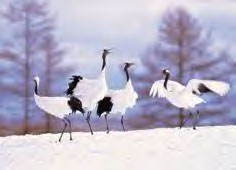 I had the great pleasure, last night, of hearing Dr George Archibald at the Lab of Ornithology. George was a student of Bill Dilger's and over the years I've heard many stories about him. Bill's very proud of having contributed in whatever small way to George's incredible ability to change the world.
I had the great pleasure, last night, of hearing Dr George Archibald at the Lab of Ornithology. George was a student of Bill Dilger's and over the years I've heard many stories about him. Bill's very proud of having contributed in whatever small way to George's incredible ability to change the world.George's life includes an number of examples of chance favoring the prepared mind. In 1967, already accepted to medical school in Canada, he hitchhiked from Montreal to Ithaca to visit the Ornithology Lab. There entirely by chance he met Dr Dilger and after an hour chatting about cranes, Bill asked, "Why don't you come to Cornell to study them?"
Working in New York, George overheard a conversation in the hall outside his office including references to Aldo Leopold and Wisconsin. There he met Ron Sauey, coincidently a student of Dr Dilger’s whom George had not yet met in Ithaca. Ron’s family farm is a few miles from Leopold’s homestead in Wisconsin. George and Ron became friends and in 1973 co-founders of the International Crane Foundation in Baraboo, Wisconsin.
Getting his PhD may have taken George longer than usual because he kept pausing to save bits of the world. In 1972, he was studying Red-crowned Cranes in Japan. This flock, which winters at feeding stations, was thought to breed in Siberia. When George found that the flock was nesting in a marsh on the north end of Hokkaido and that the area was scheduled for development he launched a public awareness campaign to save the wetlands.
In 1973 George traveled to Australia to rescue captured six Sarus Cranes in Australia and brought them to Wisconsin for captive breeding. The Eastern Sarus Crane, nearly extinct in 1973 is now being reintroduced in Thailand. In the mid-1970s, living in the Korean DMZ and studying white-naped cranes, Archibald spotted four Crested Ibis. Having received permission to take them to Wisconsin to attempt captive breeding, George spent several very cold winters in Korea in a vain effort to capture them. Later, as the Bamboo Curtain lifted, two breeding pairs were located in China leading to a successful captive breeding program.
Not the least of the accomplishments of the International Crane Foundation is the captive breeding and reintroduction of Whooping Cranes, one of two North American Crane species. George achieved media notoriety courting Tex for several years. Tex had been hand-raised and was imprinted on humans. George's courtship dancing made her hormonally receptive to artificial insemination and eventually led to the hatching of her only offspring Gee Whiz.
Researchers at ICF pioneered hand-raising techniques which avoid imprinting the chicks and enable the young birds to be reintroduced to the wild. Finally, ICF has established Crane School where young Whooping Cranes learn to fly with an ultra-light. Eventually the cranes are able to migrate with the ultra-light to wintering grounds in Florida. The current ultra-light led Whooping Crane migration began last week. You can follow it's progress here.
George Archibald is the 2006 recipient of the Indianapolis Prize. designed "to be a great, enthusiastic, spectacular celebration of victories. ... to inspire the general public to start caring in a way they’ve never cared before, and to place heroes who often live in tents, in danger from both wild beasts and human enemies, on the same pedestal that we usually reserve for sports and entertainment stars.” I'm proud to count George Archibald among my heroes.

2 comments:
Great post - I'm sorry I missed George's talk last night. It sounds like it was a very interesting talk.
Sounds like an interesting guy. I don't think I'd want to know any more about his "courtship dance" for Tex...
Post a Comment